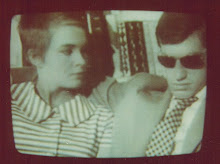I recently heard a live reading of Ginsberg's famous poem, Howl. Then I watched a movie called Heartbeat, a dramatization based on a story by Carolyn Cassady (Neal's 2nd wife), about Jack Kerouac and Neal Cassady, the two wild and crazy writers loved by Ginsberg. That led me to Carolyn Cassady's other book, Off The Road. Each piece adds a bit more to the large story of an artist among a family of artists who left a big mark.
This film by Jerry Aaronson documents the life of Allen Ginsberg who was born just before the Great Depression in Patterson, New Jersey. He pioneered the rebel poets of the 1940s and 50s that inspired the label "beaknik." The Beat Generation were non-conformist, anarchist youth who favored jazz and led the way for the larger youth culture movement of the 1960s. Commentator of the day, William F. Buckley is featured in the film calling Ginsberg "the hippie's hippie." Leader of peaceful activism during the anti-war protests of the 1960s, he was always in the vanguard, someone who wore his hair long until everyone else did--then cut his off.
The film opens with the famous line: "The weight of the world is love." His immigrant parents instilled values of justice, freedom and equality. Father Louis was a poet and teacher. Mother Naomi was in and out of mental institutions. He was often left to care for her, a task that bred deep empathy and the soul of a poet according to interviews with his brother, Eugene, and stepmother, Edith. He inherited her poetic paranoia and he too went on to spend some time inside a mental hospital.
Ginsberg met William Burroughs, Jack Kerouac and Neal Cassady while attending Columbia University during the mid 1940s. Still in the grips of corformity, his association with Burroughs soon loosened that knot. Burroughs took on the role as analyst for both Ginsberg and Kerouac by offering them daily sessions on the couch unraveling their personal problems. This growing group of supplementary family would heal Ginsberg's feeling of benig unloved. A group of poets and artists met nightly at Foster's Cafeteria in Times Square.
Poet Michael McClure describes the Eisenhower years as the beginning of the industrial corporate state and missile consciousess as the threat of nuclear weapons was front and center as a polarization of two groups emerged. Most people bought into the hope of an American Dream. A smaller group of artists and dreamers felt a growing alienation and pain.
Ginsberg came out as a gay man and met his life partner, Peter Orlovsky. They left New York for California and Ginsberg read his now-famous poem, Howl (for Carl Solomon) at the SanFrancisco Six Gallery in 1955 (http://www.youtube.com/watch?v=MVGoY9gom50). Ginsberg later defined this moment as "a united front of pure angelic poetry." Michael McClure, Gary Snyder and several others also read that night. Carl Solomon was another psychiatric patient Ginsberg met while hospitalized. The reading caused a stir that resulted in his arrest for obscene language. The court trial is the subject of a 2010 film called Howl.
Timothy Leary claims that a visit by Ginsberg and Orlovsky at Harvard during his 1960s LSD experiments changed his life. Up until that time, he was an "uptight" professor. After experiencing the liberation of Ginsberg's being, Leary changed his ways to become the psychadelic hipster he was later known as. Interviews with Dick Cavett, Ed Sanders, Ken Kesey, Abby Hoffman and many others add to telling of Ginsberg's story.
Cassady died in 1968. Kerouac died in 1969. Ginsberg mourns his passing: "While I'm here I'll do the work--and what is the work? Drunken Dumbshow."
The 1970s began a chapter of increased spiritual development and buddhist meditation after a chance encounter on a New York street corner when he met Chogyam Trungpa who told him that in order for his buddhist meditators to be able to speak about liberation of mind to America, they would need to develop the golden mouth of a poet--thought patterns become elegant as spontaneous mind is cultivated. Trungpa invited Ginsberg to teach poetry. The Jack Kerouac School of Disembodied Poetics at Naropa Insitute was founded.
Ginsberg's home was always New York. He maintained his east village apartment (down the street from where I lived 1979-1992) until his death. During 1985 he was given a show of his photographs at the Holly Solomon Gallery. He had begun his hobby during 1952 when he purchased a Kodak Retina camera for $13 and began snapping shots of his friends and had them developed at the drug store across from Tompkins Square Park. During the next thirty years, his snapshots of friends had become a collection of famous people.
There are other documentaries about the Beats, but this one is a lovely tribute to an artist who was also a significant force of history. Ginsberg lived until 1997. Peter Orlovsky just died in 2010.
12/29/10
Subscribe to:
Post Comments (Atom)





No comments:
Post a Comment